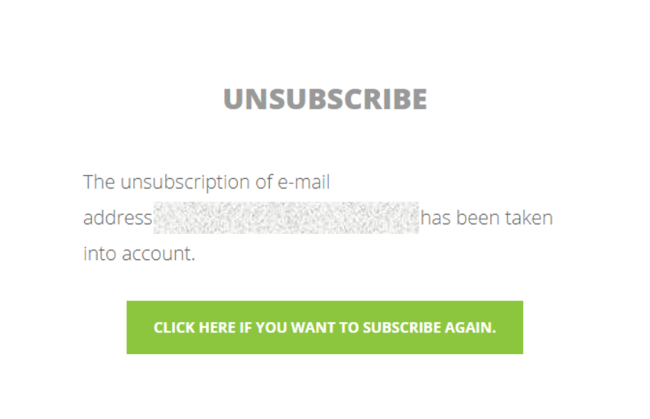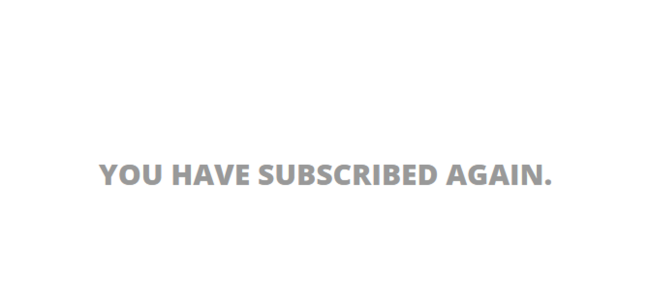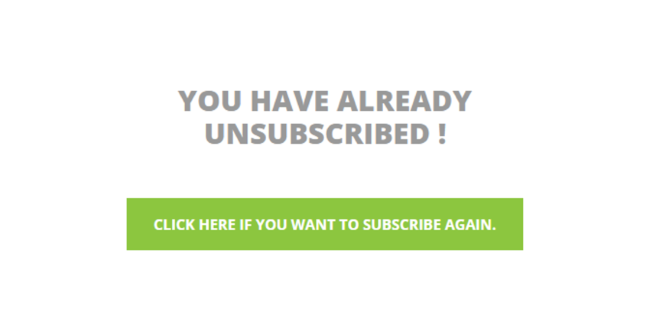Understanding the automatic unsubscribing process
Actito provides a default automatic unsubscribing process based on the 'one click unsubscribe' principle.
This principle is good practice when it comes to optimal deliverability, because it allows the reader to unsubscribe as quickly and as easily as possible. It is indeed better to let the reader unsubscribe without any frustration rather than to prevent them from unsubscribing and to force them to continue to receive e-mails that do not interest them anymore. In turn, this frustration could damage their perception of the brand and even cause them to signal the e-mail as spam.
Actito's standard unsubscribing page
If the reader clicks on the unsubscribing link at the bottom of an e-mail, they will be directed to the standard unsubscribing page.
They will be immediately unsubscribed: the cancellation of their subscription is registered in Actito as soon as the link is clicked on.

The reader has the possibility to subscribe again by clicking on the button below the message.
They would be directed to another page informing them of their re-subscription.
This re-subscription is registered in Actito as soon as the button is clicked.

If the reader clicks on the 'unsubscribe' link in the e-mail while having unsubscribed already, they will be informed that they already unsubscribed.
They will still have the possibility to subscribe again by clicking on the relevant button.
This kind of situation can occur in various cases:
-
if the reader has already clicked on the 'unsubscribe' link in the e-mail
-
if the reader unsubscribed between the time of the campaign launch and the time of the click (they may unsubscribed from another channel)
-
in a test e-mail: it means that your test profile had already unsubscribed

Each unsubscribe link is specific to each profile.
If a profile is deleted, interactions linked to it will be deleted as well. As such, the link will become invalid, even if the profile is created again later with the same e-mail address.
The Webmail's own unsubscribe button
Some Webmails (for instance, Gmail or Yahoo) choose to display their own unsubscribe link at the top of the e-mail.
This links works exactly like the Unsubscribe link generated by Actito. It is not the same as the 'report as spam' button, which means it's a good thing when it is displayed.
The link itself is not created from nowhere by the webmail: it is generated by a technical List-Unsubscribe header provided by the e-mail sender.
Starting 2024, Gmail and Yahoo have made this List-Unsubscribe header mandatory for marketing e-mails.
Good news, the header is already automatically provided by Actito in all marketing e-mails with a Subscription! Which means that you do not need to do anything to follow these rules.
Read more deliverability insights about these changes here!
While it's technically possible to send marketing e-mails without a subscription, it is unadvised, even more so considering that in this case, a List-Unsubscribe header cannot provided as an unsubscribed cannot be processed (there is no subscription to unsubscribe from!). This means that marketing e-mails without a subscription are at risk to be filtered by Gmail or Yahoo.
Transactional e-mails do not require an unsubscribe link nor a List-Unsubscribe header.
Even if a List-Unsubscribe header is provided, webmails like Gmail do not always display their own unsubscribe button. The criteria they follow are not documented, but with the changes mandated starting 2024, we expect this practice to become more generalized.